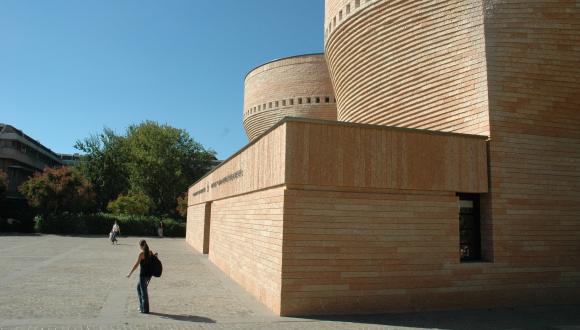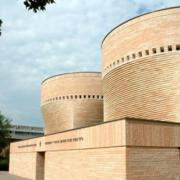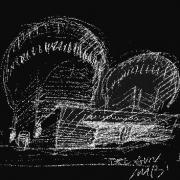Norbert Cymbalista
Why Did I Want to Build a Synagogue?
I should have asked myself this question in 1996, when I started this adventure. But I was so busy then, putting the pieces of the puzzle together, that I had no time to look for psychological explanations. Two years after the inauguration, I still try to understand the motives.
It might well all have started, when I was very young, with my seeing the dedicatory plaque, on the wall of the synagogue in my native town of Worms, that stated that a couple had erected and offered the building in 1034. This synagogue, the oldest in Europe, has since been destroyed by the Nazis. Did I want to rebuild a similar structure, in a place where it would stand forever? Or was it a simply that I had discovered the only place in the world, where 30,000 Jews had no place for prayer? Or was it that Tel Aviv University, considering itself the stronghold of Israeli secularism, seemed not eager to at all to have a synagogue? Or was it the temptation to build a small sanctuary, as the Talmud Bavli (Megillah 29a) describes synagogues, comparing them to the major and real Temple, destroyed two millennia ago?
But, no matter what, I had a challenge on my hands and many incentives for action.
The decision of what architect to choose was rather easy. I had, for a long time, admired Botta's buildings. In my mind, he is the builder of fortresses. The fortresses of the Art – the museums, the fortresses of the Money – the banks, and the fortresses of the faith – the churches, the cathedral and, why not, the synagogue. What puzzled many of my friends was the fact that Mario Botta was not Israeli, not Jewish and especially, that he had never been in a synagogue. To me, for all these reasons, he seemed to be the right person to come up with something totally new, unencumbered by reminiscences and tradition. And I wanted a building that would be strikingly modern and, at the same time, give a feeling of protection – a combination that is not easy to achieve. In short, he seemed the right man.
To work with Mario, was pure joy. It started with the choice of the location. He asked for, and obtained the site, that is precisely the very center of the University campus, surrounded by greenery and which integrates the monument for the Fallen Students, a place for remembrance and meditation. This choice was determined not only for practical motives, to make the Center easily accessible to everyone on campus, but also by the fact, that in its centrality, it hinted at the Greek Agora, the meeting ground of all voices and opinions. And then Botta set out to conceive the synagogue.
It started as a synagogue. But around that time, Prime Minister Rabin was murdered by a fellow Jew. It confirmed my fears, that the most dangerous problem facing Israel was the rift, the abyss, between the religious and the secular segments of Israel's population, which could tear the country apart. And I saw an opportunity to do something positive and constructive. To create a Center, where those two realities of Israel life could meet and start a dialogue within an academic environment. This, of course, required an adequate space. So, the auditorium was born. A Beth Hamidrash (study facility) was included, as it is a must for any Jewish religious Center. Some commentators even affirm that the place for studies is more important than the synagogue itself. And a Judaica Museum was added. As there is none in the Tel Aviv area. In short, we ended up with a construction, more than twice the size originally envisioned.
All this established, Mario started working. And came up with the solution, that has since been acclaimed as an innovation and breakthrough in Synagogue building. Altogether, it took two years, from the initial idea, to the inauguration of the building, in the presence of, among others, the Presidents of Israel and of Switzerland. In these two years, Mario and I and my wife Paulette (who is my constant inspiration and help, and without whom this building would certainly not adorn Tel Aviv University), all worked together. The result of our collaboration is this building and the building's soul – the interplay of space, light and sacredness.
Am I happy with the outcome? Certainly. The synagogue has at least five daily services plus some improvised ones. The Auditorium is functioning to overflowing audiences, offering meetings, symposia and lectures. The study Room, with its library and computers, is used regularly. And the Museum houses temporary exhibitions of the best Judaica collections from around the world and from Tel Aviv University itself.
And we are the only synagogue in Israel that houses and conducts, under the same roof, religious services for all three major Jewish denominations: Orthodox, Conservative, and Reform. The latter two hold their services in the Auditorium, where a mobile Aron Hakodesh (Holy Ark) is rolled in when necessary. The "Role-in Arch" is not a new concept: indeed, it is already depicted on the frieze of the Kfar Nahum synagogue from 2000 years ago.
This building, in its structure and its details, expresses concepts that are fundamental to my beliefs: the importance of Judaism in its many expressions; the belief in inclusiveness for all Jews; the value of our history and tradition in shaping who we are today; and the recognition of the sacred.
Several of the elements of the building are symbolic, representing structural and architectural solutions that highlight its purpose, its sacredness and its connection to Judaism. While others, In this book, will undoubtedly elaborate about the building. I would like to point out some characteristics which, while less evident, are still significant for understanding how and why certain choices were made. Symbolism and references to Jewish Sacred Texts are constantly present both outside and within the building:
- The letters of the writing above the entrances, in Latin and in Hebrew, are written in a script that reflects the Torah scroll writing.
- The two columns at the main entrance, are reminiscent, and a smbol of Solomon's Temple.
- The two towers and the interior spaces are perfectly equal, symbolizing the two realities of Israeli democracy, the secular and the religious.
- The one step leading down into the Orthodox synagogue reminds us of Psalm 130:1: from the depths, I am calling you.
- Light into the building comes only from above, so that we look instinctively to Heaven – or to G-d – (Psalm 115:16): Heaven is G-d's.
- The fact that there are no decorations, and not even windows, is due to the Jewish tradition that requires the people not to be distracted while they pray (Talmud Bavli, Eruvim 65a and Shulchan Aruch, Orach Chayim 98:2). As such, the embrasures in the round towers are not meant to let light in, but to let it shine out, at night - The Guardian of Israel does not slumber nor sleep (Isaiah 5:27).
- The Eternal Light (Ner Tamid) in the synagogue, a symbol of G-d's presence amid Israel (Talmud Bavli, Shabbat 22b) is not just an electric bulb, but a living flame, jutting out of the stone – Is not my word like a fire, says the Lord (Jeremiah 23:29).
- The seating order is my personal choice. I simply prefer people looking at each other, than just facing the eastern wall.
- The Mehitza (division between women and men) has been reduced to the minimum, while still remaining religiously correct: it is simply a thin metal rail, one meter high. Everyone is participant and fully part of the space.
These are the building's realities and its symbols. We completed the building according to plan and expectations and my hopes now are for it to be a place of prayer and learning, and an oasis of peace.
Let's hope that the even greater challenge, to achieve mutual respect and understanding among the Jewish communities, will ensue through our efforts, evidenced in this Cymbalista Synagogue and Jewish Heritage Center.
November 2000.





